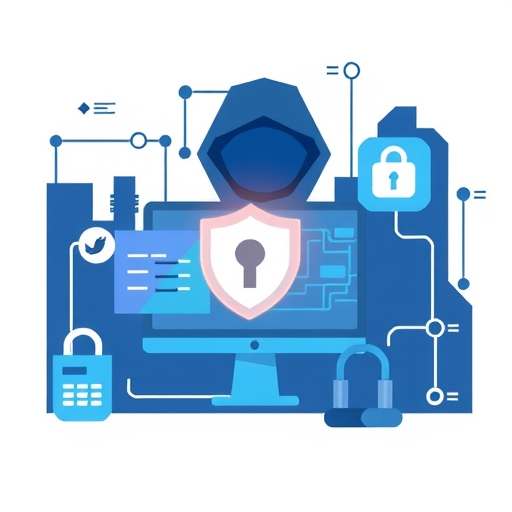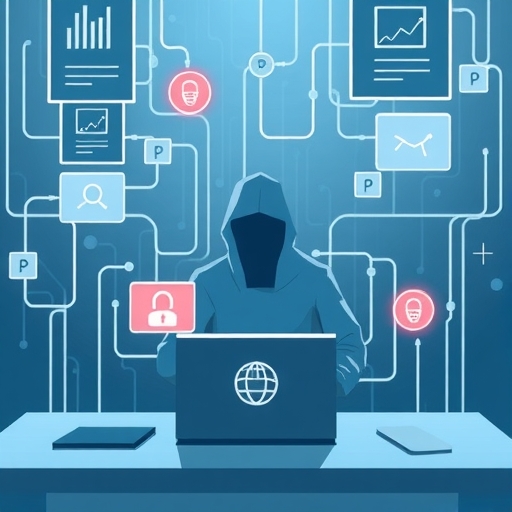Securing Your Portfolio: Investing in Cybersecurity ETFs Amidst Evolving Global Threats
Are you looking to strategically position your investment portfolio in a sector that is not only experiencing rapid growth but is also fundamentally critical to our increasingly digital world? The answer might lie in cybersecurity. In an era where digital transformation is accelerating across every industry, the threat landscape is also expanding at an alarming rate. From sophisticated AI-powered attacks to costly data breaches, the need for robust digital defenses has never been more urgent. For astute investors, cybersecurity Exchange-Traded Funds (ETFs) offer a compelling and diversified pathway to tap into this essential and high-growth sector. We will explore the escalating cyber threats, understand why ETFs are an ideal investment vehicle for this complex industry, delve into some of the leading cybersecurity ETFs, and provide guidance on how to evaluate them for a resilient investment portfolio.
The demand for robust cybersecurity solutions is driven by several key factors, highlighting its critical role in the modern economy:
- The relentless pace of digital transformation across all industries, expanding the attack surface for organizations.
- The increasing sophistication of cyber threats, including ransomware, phishing, and state-sponsored attacks.
- Strict global data protection regulations that compel businesses to invest heavily in compliance and security measures.
- The widespread adoption of cloud computing, IoT, and big data, which introduces new vulnerabilities and expands the scope of potential attacks.

The Escalating Global Cyber Threat Landscape
The digital world, while offering unprecedented convenience and innovation, simultaneously presents a growing array of vulnerabilities. Cyberattacks are no longer isolated incidents; they are a persistent and evolving menace. According to a 2024 report by IBM, the average cost of a global data breach has soared to an alarming US$4.48 million, marking a 10 percent increase year-over-year and setting a new record for the highest cost in 19 years. This statistic alone underscores the profound financial repercussions faced by businesses and governments worldwide.
Understanding the common types of cyberattacks can help illuminate the diverse challenges faced by organizations today:
| Attack Type | Description | Common Impact |
|---|---|---|
| Ransomware | Malware that encrypts files, demanding payment for decryption keys. | Data loss, operational disruption, significant financial cost. |
| Phishing | Deceptive communications designed to trick recipients into revealing sensitive information. | Credential theft, data breaches, financial fraud. |
| DDoS (Distributed Denial of Service) | Overwhelming a system with traffic to disrupt its normal functioning. | Service outages, reputational damage, financial losses from downtime. |
| Insider Threats | Security breaches or data loss caused by current or former employees. | Data theft, intellectual property loss, system sabotage. |
The rise of advanced technologies, particularly Artificial Intelligence (AI) and Quantum Computing, is reshaping the digital battlefield. While these technologies promise revolutionary advancements, they also create new vectors for sophisticated cyber threats, capable of bypassing traditional security measures. Imagine AI-powered phishing campaigns that are indistinguishable from legitimate communications, or quantum computers that could theoretically break current encryption standards. These emerging challenges demand innovative and proactive cybersecurity solutions, driving immense investment into the sector. The cybersecurity market is, in fact, projected for robust growth through 2030, with an estimated Compound Annual Growth Rate (CAGR) of 11.4% by 2029, signaling a strong upward trajectory for companies operating in this space.
New technologies are introducing complex and evolving attack vectors that demand constant innovation in defense:
- AI-driven malware capable of adapting to security measures and evading detection.
- Quantum computing threats that could render current cryptographic standards obsolete.
- Deepfake technology used for sophisticated social engineering and identity theft.
- Exploitation of vulnerabilities in interconnected IoT devices, creating vast networks for botnets or data exfiltration.

Beyond technological advancements, global trends are further intensifying the necessity for robust cybersecurity. The high-profile hack of the U.S. Securities and Exchange Commission’s (SEC) social media account in January 2024 served as a stark reminder that even regulatory bodies, which oversee the financial markets, are susceptible to digital manipulation and security vulnerabilities. This incident highlighted the potential for market disruption and the critical need for vigilance. Moreover, geopolitical conflicts are increasingly manifesting as cyberwarfare, where nation-states and non-state actors engage in digital attacks to gain strategic advantages. Simultaneously, tightening data protection regulations globally, such as GDPR and CCPA, compel businesses to invest heavily in compliance and data security. The widespread adoption of cloud computing, the Internet of Things (IoT), and big data analytics as part of ongoing digital transformation initiatives further expands the attack surface for organizations, making comprehensive cybersecurity an indispensable economic sector. Executives are clearly recognizing this shift, with over 40% identifying cyber threat monitoring as an essential organizational function, reflecting a move towards proactive digital defense strategies.
Global data protection regulations play a crucial role in shaping the cybersecurity landscape, mandating stringent requirements for data handling and protection:
| Regulation | Region/Scope | Key Focus | Impact on Cybersecurity |
|---|---|---|---|
| GDPR (General Data Protection Regulation) | European Union and EEA | Data privacy and protection for all EU citizens. | Requires robust data security measures, breach notification, and data governance. |
| CCPA (California Consumer Privacy Act) | California, USA | Consumer data rights, including access, deletion, and opt-out. | Mandates reasonable security practices to protect consumer data. |
| HIPAA (Health Insurance Portability and Accountability Act) | United States (healthcare sector) | Protection of protected health information (PHI). | Strict security standards for electronic health records and data transmission. |
| NIST Cybersecurity Framework | United States (voluntary standard) | Guidance for managing cybersecurity risks. | Provides a flexible framework for organizations to improve their cyber defenses. |
Why Cybersecurity ETFs Stand Out for Investors
Given the complexity and rapid evolution of the cybersecurity landscape, how can an everyday investor gain exposure without needing to become a sector expert or risking high volatility from picking individual stocks? This is where Exchange-Traded Funds (ETFs) shine. An ETF is a type of investment fund that holds a collection of underlying assets, such as stocks, and trades on stock exchanges like regular stocks. For the cybersecurity sector, ETFs offer a strategic advantage, allowing you to invest in a diversified basket of companies that are at the forefront of digital defense.

One of the primary benefits of cybersecurity ETFs is diversification. Instead of betting on a single company, which can be prone to specific operational risks or market whims, an ETF spreads your investment across numerous companies within the sector. This approach inherently reduces risk and can lead to a smoother investment journey. Furthermore, ETFs generally boast lower expense ratios compared to traditional actively managed mutual funds. This means a smaller portion of your investment goes towards management fees, allowing more of your capital to remain invested and potentially grow over time. We believe this makes them a cost-effective choice for long-term growth.
The advantages of investing through ETFs are particularly pronounced in a specialized sector like cybersecurity:
- ETFs provide instant diversification across multiple companies, mitigating the risk associated with individual stock performance.
- They offer liquidity, as they can be bought and sold throughout the trading day like stocks.
- ETFs typically have lower management fees compared to actively managed mutual funds, preserving more of your investment capital.
- They allow investors to gain exposure to niche sectors or themes without requiring extensive individual company research.
Investing in individual cybersecurity stocks often requires extensive research, deep industry knowledge, and a high tolerance for volatility. The sector includes many innovative but smaller companies that might be highly speculative. By choosing a cybersecurity ETF, you gain simplified access to the entire industry’s growth potential without the heavy lifting of individual stock analysis. You’re entrusting the fund manager to select and manage a portfolio of companies that are best positioned to benefit from the escalating demand for cybersecurity solutions, from network security and cloud security to identity management and threat intelligence. This hands-off approach makes cybersecurity ETFs an attractive option for both novice and experienced investors seeking exposure to this vital growth sector.
Comparing ETFs to other investment vehicles highlights their unique benefits for sector-specific investment:
| Feature | Cybersecurity ETF | Individual Cybersecurity Stock | Actively Managed Mutual Fund |
|---|---|---|---|
| Diversification | High (across many companies) | None (single company risk) | High (diversified, often broader scope) |
| Expense Ratio | Generally Low to Moderate | N/A (no fund fees) | Generally High |
| Trading Flexibility | Traded like stocks throughout the day | Traded like stocks throughout the day | Traded once daily at market close |
| Research Required | Moderate (fund strategy, holdings) | High (company financials, industry trends) | Low (manager performs research) |
Exploring Leading Cybersecurity ETFs for a Resilient Investment Portfolio
When considering an investment in cybersecurity ETFs, it’s helpful to look at some of the prominent players in the market. These funds offer varying strategies, holdings, and expense ratios, allowing you to choose one that aligns with your investment goals. Here, we’ll profile some of the top US-listed cybersecurity ETFs, focusing on their key characteristics.

Let’s take a closer look at some of these funds:
- First Trust Nasdaq Cybersecurity ETF (CIBR): Established in 2015, CIBR is often considered the largest pure-play cybersecurity ETF by Assets Under Management (AUM), currently nearing $10 billion. It aims to track the Nasdaq CTA Cybersecurity Index, providing diversified exposure to companies engaged in the cybersecurity industry. Its top holdings typically include industry giants like Broadcom, Cisco Systems, and Palo Alto Networks.
- Amplify Cybersecurity ETF (HACK): As one of the oldest cybersecurity ETFs, launched in 2014, HACK tracks the ISE Cyber Security Index. It generally has a more concentrated portfolio compared to CIBR. Key holdings often feature prominent names such as Broadcom, CrowdStrike Holdings, and Cisco Systems, focusing on companies that derive a significant portion of their revenue from cybersecurity.
- Global X Cybersecurity ETF (BUG): Launched in 2019, BUG is a newer entrant but has quickly gained traction. This ETF is specifically concentrated on companies that generate at least 50% of their revenue from cybersecurity. Its holdings often include high-growth innovators like CrowdStrike, Fortinet, Zscaler, and Check Point Software Technologies, making it an option for investors seeking a more focused exposure to core cybersecurity providers.
- WisdomTree Cybersecurity Fund (WCBR): Established in 2021, WCBR focuses on companies at the forefront of cybersecurity innovation. Its portfolio tends to include leaders in next-generation security solutions. Top holdings typically feature companies such as Palo Alto Networks, CrowdStrike Holdings, Datadog Inc., and Cloudflare.
- iShares Cybersecurity and Tech ETF (IHAK): Also established in 2019, IHAK offers a broader technology exposure with a significant allocation to cybersecurity companies. It tends to have a slightly lower expense ratio than some pure-play counterparts, making it an attractive option for those seeking a balance between focused cybersecurity and broader tech exposure.
For comparative purposes, we can also consider broad-based technology ETFs like the Vanguard Information Technology ETF (VGT). While not a pure-play cybersecurity ETF, VGT includes cybersecurity companies within its diverse technology holdings and boasts an exceptionally low expense ratio, offering a highly diversified approach to the tech sector as a whole. However, if your goal is targeted exposure to the cybersecurity theme, the specialized ETFs mentioned above would be more appropriate.
To give you a clearer picture, here’s a comparative overview of some key US-listed cybersecurity ETFs:
| ETF Ticker | ETF Name | Inception Date | Approx. AUM (Billions) | Expense Ratio (%) | Top Holdings Example |
|---|---|---|---|---|---|
| CIBR | First Trust Nasdaq Cybersecurity ETF | Jul 2015 | ~$9.9 | 0.60 | Broadcom, Cisco Systems, Palo Alto Networks |
| HACK | Amplify Cybersecurity ETF | Sep 2014 | ~$1.8 | 0.60 | Broadcom, CrowdStrike Holdings, Cisco Systems |
| BUG | Global X Cybersecurity ETF | Oct 2019 | ~$1.3 | 0.50 | CrowdStrike, Fortinet, Zscaler |
| WCBR | WisdomTree Cybersecurity Fund | Jan 2021 | ~$0.4 | 0.45 | Palo Alto Networks, CrowdStrike Holdings, Datadog Inc. |
| IHAK | iShares Cybersecurity and Tech ETF | Jun 2019 | ~$0.4 | 0.47 | Palo Alto Networks, Broadcom, CrowdStrike Holdings |
(Note: AUM and holdings are approximate and subject to change based on market conditions and fund rebalancing.)
Decoding ETF Performance and Making Informed Choices
Once you’ve identified a few potential cybersecurity ETFs, how do you choose the right one for your portfolio? Evaluating ETFs goes beyond just looking at their names. We recommend examining several key metrics and factors to make an informed decision:
- Assets Under Management (AUM): Generally, larger AUM indicates higher liquidity and investor confidence. Funds with significant AUM are less likely to be closed down due to lack of interest.
- Expense Ratio: This is the annual fee you pay as a percentage of your investment. Lower expense ratios mean more of your money stays invested, which can significantly impact long-term returns. While cybersecurity ETFs might have slightly higher expense ratios than broad market ETFs (e.g., S&P 500 funds), compare them within the cybersecurity sector.
- Holdings and Investment Strategy: Dive into the fund’s top holdings. Does it align with your view of the cybersecurity market? Some ETFs focus on pure-play cybersecurity companies (e.g., BUG), while others might include broader tech firms with significant cybersecurity segments (e.g., IHAK). Understand if the ETF targets innovators, established players, or a mix.
- Historical Performance: While past performance is not indicative of future results, looking at annualized returns over different periods (1-year, 3-year, 5-year) can give you an idea of how the fund has performed relative to its peers and the broader market. Also, consider dividend yields, though many growth-focused tech ETFs may offer minimal or no dividends.
- Tracking Error and Beta: The tracking error measures how closely the ETF’s performance mirrors its underlying index. A lower tracking error is generally preferred. Beta measures the fund’s volatility relative to the overall market; a beta greater than 1 suggests higher volatility.
Now, let’s weigh the benefits and drawbacks of investing in cybersecurity ETFs:
Pros of Cybersecurity ETF Investing:
- Broad Sector Exposure: You gain diversified access to the entire cybersecurity industry without needing to research individual companies.
- Simplified Investment: ETFs offer a straightforward way to participate in a complex and high-growth sector.
- Potential for Industry-Wide Growth: As cyber threats escalate and digital transformation continues, the demand for cybersecurity solutions is almost guaranteed to grow, benefiting the entire sector.
- Cost-Effective: Generally lower fees compared to actively managed mutual funds.
Cons of Cybersecurity ETF Investing:
- Higher Expense Ratios: Compared to very broad market ETFs (like those tracking the S&P 500), specialized sector ETFs typically have slightly higher expense ratios.
- Less Upside Potential Than Individual Stock Picking: While diversification reduces risk, it also means you might miss out on the explosive growth of a single, exceptionally successful cybersecurity stock.
- Concentration Risk: Although diversified within the sector, you are still concentrating your investment in one specific industry. A downturn in the technology sector or a major shift in cybersecurity trends could impact your investment.
Ultimately, the decision to invest in cybersecurity ETFs should align with your broader investment strategy and risk tolerance. Are you comfortable with the potential volatility of a growth-oriented tech sector? Do you believe in the long-term necessity and expansion of digital defense? If so, these ETFs could be a valuable addition to your portfolio.
Conclusion
The digital age is defined by connectivity, but with that connectivity comes an inescapable truth: the persistent and escalating threat of cyberattacks. As we’ve seen, from the rising costs of data breaches to the emergence of AI-powered threats and high-profile incidents like the SEC hack, robust cybersecurity is no longer a luxury but an absolute necessity. This creates a compelling investment thesis for the cybersecurity sector, which is projected for significant growth in the coming years.
For investors seeking to capitalize on this critical trend, cybersecurity Exchange-Traded Funds (ETFs) offer an accessible, diversified, and cost-effective solution. By investing in an ETF, you gain exposure to a basket of leading companies—from established giants like Cisco and Broadcom to innovative disruptors like CrowdStrike and Zscaler—all working to build our digital defenses. While evaluating factors like AUM, expense ratios, and specific holdings is crucial, the overarching benefit lies in participating in an essential industry without the burden of individual stock picking.
We believe that cybersecurity ETFs provide a strategic avenue to build a resilient portfolio, positioning you to benefit from the relentless march of digitalization and the ever-growing demand for digital protection. As the world becomes increasingly interconnected, investing in the companies safeguarding that connection can be a smart move for long-term capital appreciation.
Disclaimer: This article is for informational and educational purposes only and should not be considered as financial advice. Investing in Exchange-Traded Funds (ETFs) and the stock market involves risks, including the potential loss of principal. Always conduct your own research and consult with a qualified financial advisor before making any investment decisions.
Frequently Asked Questions (FAQ)
Q: What is a cybersecurity ETF and why should I consider investing in one?
A: A cybersecurity ETF (Exchange-Traded Fund) is an investment fund that holds a diversified collection of stocks from companies operating in the cybersecurity sector. You should consider investing in one because it allows you to gain exposure to the high-growth cybersecurity industry with built-in diversification, lower costs than actively managed funds, and simplified access compared to researching individual stocks.
Q: What are the main risks associated with investing in cybersecurity ETFs?
A: While cybersecurity ETFs offer diversification within the sector, they still carry concentration risk, meaning your investment is focused on one industry. Other risks include market volatility inherent to the technology sector, the potential for higher expense ratios compared to broad market ETFs, and the possibility of missing out on explosive growth from a single, exceptionally successful stock due to diversification.
Q: How do I choose the right cybersecurity ETF for my portfolio?
A: To choose the right cybersecurity ETF, consider several factors: the fund’s Assets Under Management (AUM) for liquidity, its Expense Ratio to minimize fees, its specific holdings and investment strategy to ensure it aligns with your market view (e.g., pure-play vs. broader tech exposure), and historical performance as an indicator of past returns. Always align your choice with your personal investment goals and risk tolerance.



No responses yet